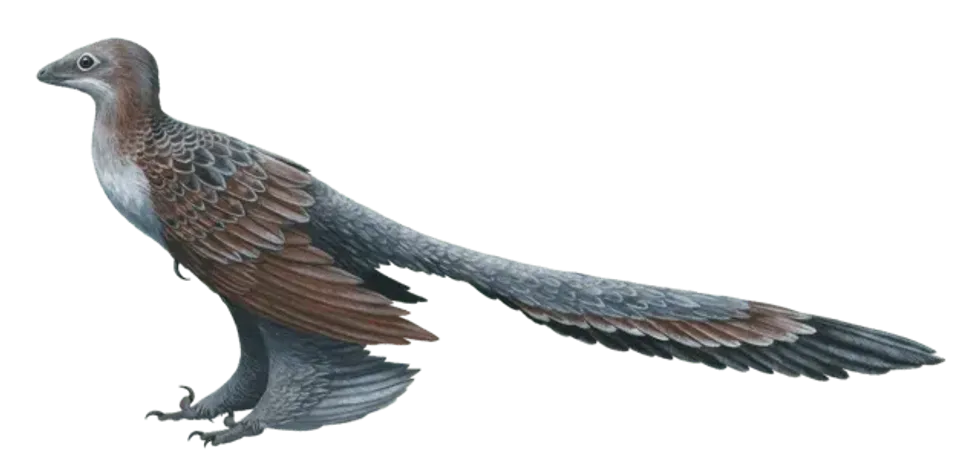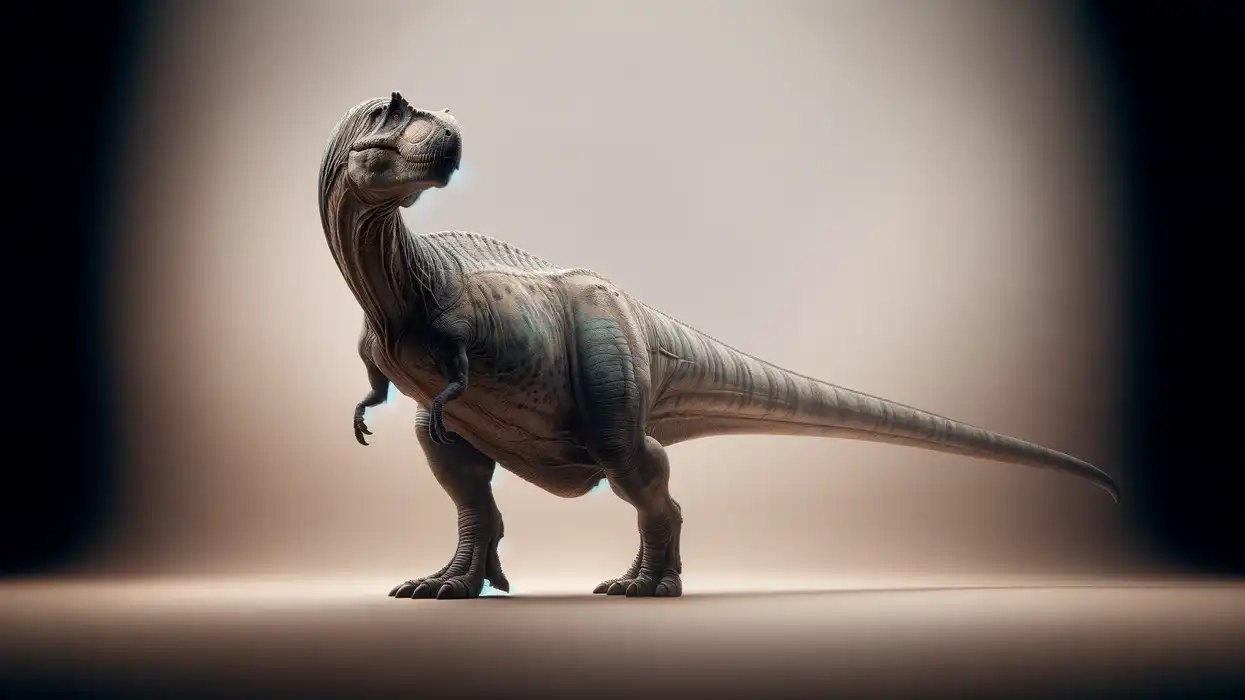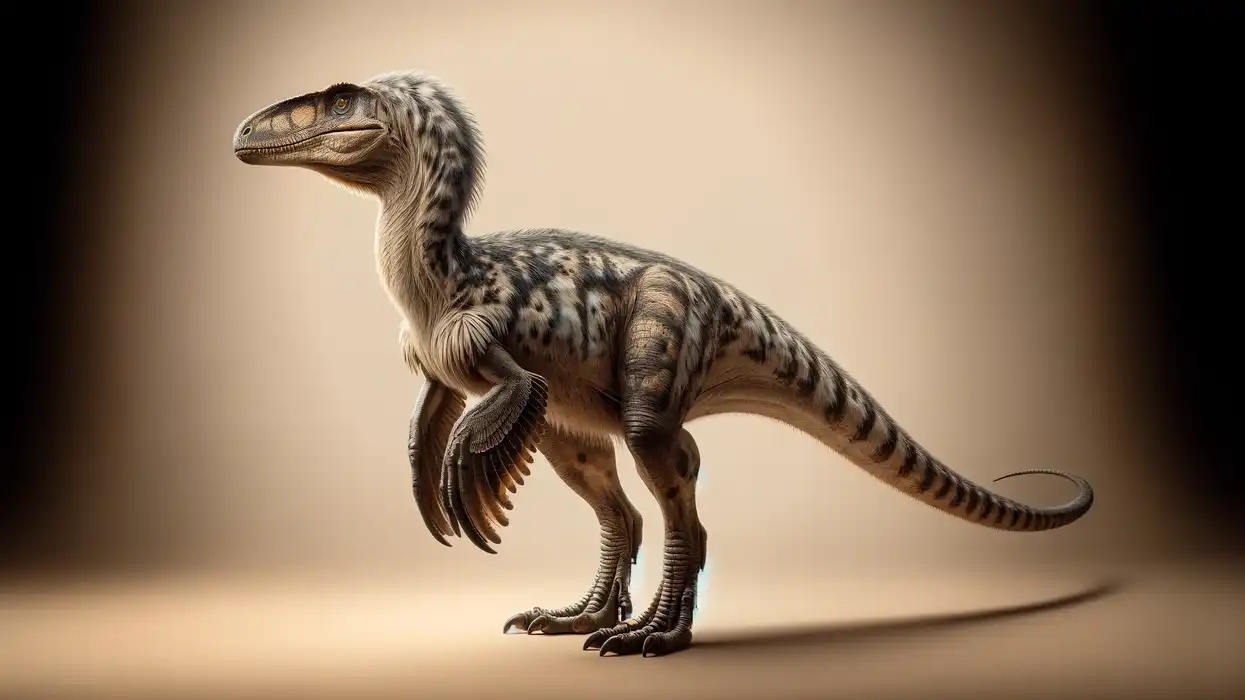The Changyuraptor raptor is a genus of four-winged dinosaurs. These dinosaurs are highly predatory.
It is known for its single fossil specimen. This four-winged dinosaur was discovered to have lived in the Early Cretaceous era which was almost 125 million years ago.
The Changyuraptor had long feathers all over its body. These long feathers were present on the forelimbs and hindlimbs, which gave the appearance of having two pairs of wings.
The presence of feathers on all four limbs suggests that these dinosaurs could fly and can be rightly called flying dinosaurs. The dinosaur's tail was long and had tail feathers.
These tail feathers were as long as 11.5 in (29.3 cm) in length which was approximately 30% of the total length of this bird.
The exact diet of this dinosaur has not yet been discovered but fossils of similar dinosaurs have been found with fish and birds in their guts which brings scientists to the conclusion that this could have been their primary diet.
For more relatable content, check out these Austroraptor facts and Incisivosaurus facts for kids.
Changyuraptor Interesting Facts
How do you pronounce 'Changyuraptor '?
The name of the Changyuraptor dinosaur is pronounced as 'Chang- U- rap- tor' and is known for being a single fossil specimen and the largest four-winged dinosaur that lived during the Early Cretaceous period, nearly 125 million years ago.
What type of dinosaur was a Changyuraptor?
The Changyuraptor raptor, meaning long tail feathers, is a genus of four-winged dinosaurs. These dinosaurs are highly predatory species. It is known for its single fossil specimen discovered that represents the species of the Changyuraptor yangi.
This four-winged dinosaur was discovered in the Early Cretaceous era which was almost 125 million years ago. Its deposits were found in the Liaoning Province in China.
The Changyuraptor yangi belongs to the group of dromaeosaurid theropod dinosaurs called the Microraptoria. At the time of its discovery and even today, the Changyuraptor yangi is the largest four-winged dinosaur. It even stands among the largest Mesozoic flying paravians.
In which geological period did the Changyuraptor roam the earth?
The Changyuraptor yangi roamed the earth during the Early Cretaceous era which was almost 125 million years ago. Its deposits were found in Liaoning Province in modern-day China.
When did the Changyuraptor become extinct?
The Changyuraptor yangi became extinct around 133 million-110 million years ago during the Early Cretaceous era.
Where did a Changyuraptor live?
The Changyuraptor yangi lived in terrestrial regions. Changyuraptor dinosaur fossils were found in the Liaoning Province in China. This is why it is assumed that this dinosaur inhabited China and parts of Asia that surround China.
What was a Changyuraptor's habitat?
These dinosaurs preferred living in terrestrial regions. They inhabited the Liaoning Province in China and few other Asian countries that surround China.
This long feathered dinosaur became extinct nearly 125 million years ago.
These hunters may not have caught their prey in the air but they may have spent a lot of their lives high up in the trees and on high altitudes living an arboreal life. Analysis of their stomach content indicates that these dinosaurs, closely related to the Velociraptor, possibly ate small mammals, lizards, and even primitive birds.
Who did a Changyuraptor live with?
This feathered dinosaur lived with various other dinosaurs of similar kinds in a group as well as its own. The stomach content analysis of this Changyuraptor dinosaur fossil indicates that these dinosaurs, closely related to the likes of Velociraptor and possibly ate small mammals, lizards, and even primitive birds. They probably even shared a similar habitat and territory.
How long did a Changyuraptor live?
The exact timeline of the existence of this feathered dinosaur is not available to mankind. However, what we do know is that they lived during the Early Cretaceous period, nearly 110-120 million years ago.
These dinosaurs would have lived for at least a million years if not more. These dinosaurs belong to the recently discovered new species of flying dinosaurs with wings.
How did they reproduce?
The exact reproduction process of this new species is not known to us and nor has it been explicitly assigned an authentic source of information.
But as suggested by the news and new discoveries, this dinosaur was an egg-laying species similar to most reptiles of today with related ancestral animal families. It is assumed that this species laid an average of two to five eggs.
A recent discovery states that nearly 70 new species were capable of laying eggs at very high altitudes and this Changyuraptor flying dinosaur has been listed as one of them.
Changyuraptor Fun Facts
What did a Changyuraptor look like?
 *We've been unable to source an image of Changyuraptor and have used an image of Microraptor instead. If you are able to provide us with a royalty-free image of Changyuraptor, we would be happy to credit you. Please contact us at hello@kidadl.com.
*We've been unable to source an image of Changyuraptor and have used an image of Microraptor instead. If you are able to provide us with a royalty-free image of Changyuraptor, we would be happy to credit you. Please contact us at hello@kidadl.com. The Changyuraptor had long feathers all over its body. These long feathers were present on the forelimbs and hindlimbs, which gave the appearance of having two pairs of wings.
The presence of feathers on all four limbs suggests that these dinosaurs could fly and be rightly called a flying dinosaur. The dinosaur's tail was long and had tail feathers. These tail feathers were as long as 11.5 in (29.3 cm) long which was approximately 30% of the total length of this bird.
These wings gave the bird momentum to fly at great speed. This new species had elongated feathers that are thought to have helped provide softer and safer landings.
These tail feathers served as a blessing to these dinosaurs in a number of ways. They even helped the bird catch its prey and protect itself from predators. Its legs were comparatively short for its body but added extra advantages when this group of dinosaurs were flying.
The legs too were covered in feathers. These feathered legs helped this species gain momentum while flying over its predators and prey.
How many bones did a Changyuraptor have?
This species had a mid-sized skeleton with multiple bones found across China in terrestrial regions. Despite knowing so much about the genus and family of this dinosaur the exact number of bones in its body has not been accurately determined. The discovery of the remains of its body do suggest that it had some very long feathers.
How did they communicate?
This dinosaur may have used loud voices and visual forms of communication. As per paleogeographic implications, the exact model of communication that took place between these dinosaurs is not yet known to man.
But it is assumed that they might have used their voices and body language. Paleontologists still need to explore the exact mode of communication in order to draw a conclusion.
How big was a Changyuraptor?
This species is the newest member of the group of Microraptorines. It is also the largest theropod dinosaur discovered to date which is long feathered and also a flying dinosaur.
It is three times larger than the largest species of Microraptor –Microraptor zhaoianus. It is 47.2 in (1.2 m) in length which is the average size of the members of Microraptorines.
How fast could a Changyuraptor move?
The Changyuraptor was quite a swift-flying dinosaur. This species could be a hero at gliding. New discoveries suggest that this flying dinosaur was so good at flying and gliding that it could easily escape its predators and even get a good grip over its prey in no time.
How much did a Changyuraptor weigh?
The weight of this flying dinosaur was 8.8 lb (4 kg). It was a prety lightweight bird which is why it could fly at a great speed.
What were the male and female names of the species?
No gender-specific names were given to the male and female species of these Microraptorines members.
What would you call a baby Changyuraptor?
Dinosaurs are hatched from eggs, therefore new baby dinosaurs can be called hatchlings.
What did they eat?
The exact diet of this dinosaur has not yet been discovered but fossils of similar dinosaurs have been found with fish and birds in their guts which brings scientists to the conclusion that this could have been their primary diet.
How aggressive were they?
This dinosaur species was quite aggressive in nature. Given the size and shape of their body, these seem like they were sharp hunters with great defending skills.
Did you know...
Luis Chiappe was the first scientist who studied this species. It was Chiappe who lead the international team of scientists into the discovery and understanding of this bird.
This dinosaur is one of the biggest flying dinosaurs to have ever been studied by scientists.
The entire skeleton of this dino has been preserved in the Natural History Museum of Los Angeles. The Natural History Museum of Los Angeles is very popular because of this dinosaur.
The Natural History Museum of Los Angeles is located in the Exposition Park in the USA.
Which is the largest flying dinosaur?
The Quetzalcoatlus is the largest flying dinosaur to have ever roamed the earth. It is a pterosaur known from the Late Cretaceous period of North America.
Which land dinosaur existed at the time of Changyuraptor?
A large number of land dinosaurs existed during the Early Cretaceous period. The species included Shantungosaurus, Triceratops, ichthyosaurs, and many more.
Here at Kidadl, we have carefully created lots of interesting family-friendly dinosaur facts for everyone to discover! Learn more about some other dinosaurs from our Juravenator surprising facts and Wintonotitan fun facts for kids pages.
You can even occupy yourself at home by coloring in one of our free printable Changyuraptor coloring pages.
Main image by Emily Willoughby.
Second image by Matt Martyniuk.









